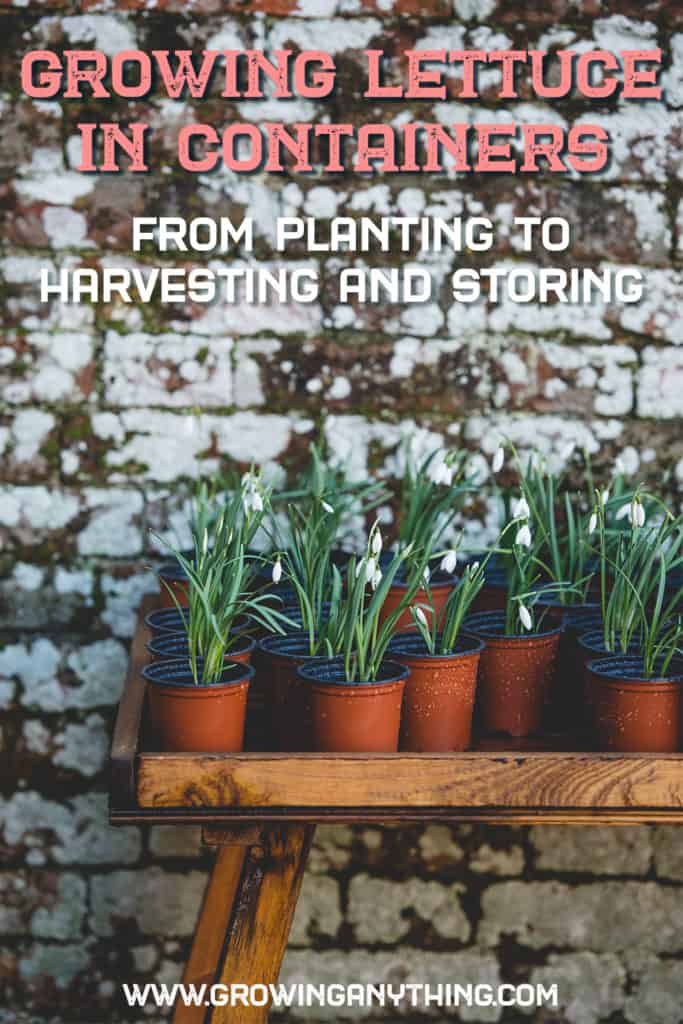How to Grow Lettuce in A Containers
How do you feel about growing lettuce in containers? If growing your greens seems like a great idea, but lack of space was always an issue, here is what you need to know! The article will teach you how to grow lettuce in pots and have fresh and crispy homegrown salad!
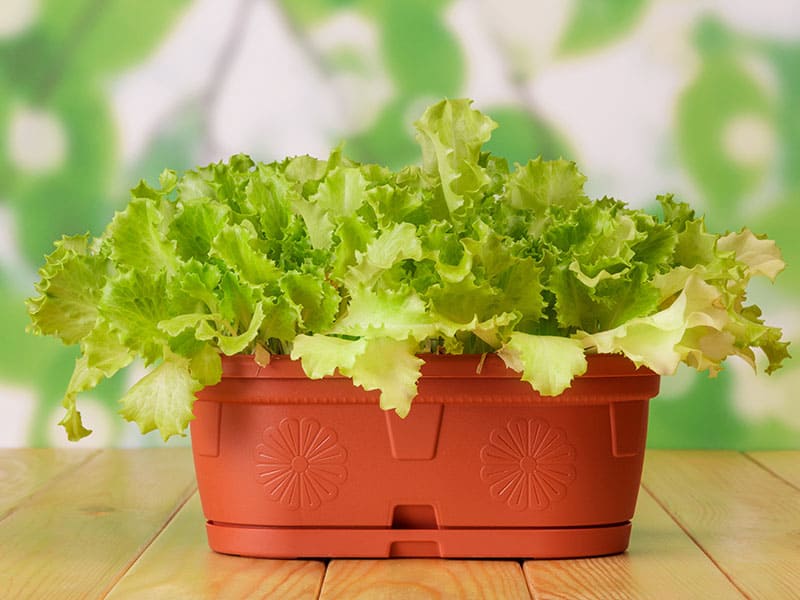
There are things to know to be successful in it, including the soil type, suitable location, irrigation, dealing with pests and diseases and more.
Also, I will walk you through the lettuce varieties suitable for growing in pots, so you know what seeds to get.
Ultimately, let’s talk more about harvesting and storing so you are fully prepared to start growing lettuce in pots!
Choosing Seeds
In general, all lettuce varieties are suitable for pots. But, varieties with loose leaves are better suited for container growing, and the head lettuce thrives in garden soil. Also, loose-leaf types have better heat tolerance and you can harvest them gradually.
Here is a brief overview of lettuce varieties you can choose for your containers!
Green and Red Oakleaf Lettuce
Red and green Oakleaf lettuce are two popular loose-leaf varieties of lettuce. Leaves are tender and shaped like oak-foliage, hence the names. Stems are also crunchy and they don’t need a lot of time to mature and get burgundy color.
You can start them in winter! Wait for the deep color to show and sweet flavor to produce.
Verigo Lettuce
Verigo lettuce has a beautiful flavor and a crisp texture. It also features a lot of uniform leaves and is commonly used in sandwiches for giving extra crunch!
Rubygo Lettuce
Rubygo is showy and flavored lettuce with red leaves and a crunchy texture. The lettuce remains compact when mature, so it is an excellent choice for people with limited space. Like Verigo, Rubygo lettuce is a common ingredient in delicious sandwiches!
Red Romaine Lettuce
Red Romaine lettuce is available year-round. It is another compact variety, and Red Romaine has elongated, tender, and upright leaves.
The lettuce features a mild and somewhat neutral taste, so you can mix it with a vast range of ingredients. It is perfect for salads, and you can harvest it as baby lettuce or wait for the leaves to mature.
Pick the Soil Well
Soil is an important factor for growing healthy lettuce. Get an excellent quality soil mix to start lettuce on the right track. Ideally, it should contain a high percentage of organic matter.
You can manually add compost or peat or use dry grass to ensure proper pH value for lettuce. It will also help if the soil is sandy or clay.
The soil needs to be loose and well-drained to prevent wet feet. Adding perlite or vermiculite can improve drainage.
On average, you’ll need between one and three gallons of soil, but the exact amount depends on the size of your container. If you plan to enjoy the repeated harvest, look for Cut and come again label on soil mixes.
Before you plant the seeds, loosen the soil at ten inches depth. At that point, before planting, you can add well-rotted manure to improve the growing conditions.
What About the Pots?
Deciding on pots for growing lettuce is relevant if you want to get the most of your lettuce and available space. In general, lettuce doesn’t have a deep root system. Therefore, you can grow lettuce in shallow pots. The minimum depth a pot for lettuce should have is six inches.
Therefore, pick shallow and elongated pots to expand your surface area. The same applies to growing a variety of greens with shallow roots, like kale and spinach.
If you prefer round pots, choose the ones with a minimum diameter of ten and 12 inches and the same depth.
Planting Lettuce
The ideal time to plant lettuce seeds is after the frost has passed. You can choose to sow the seeds directly into pots with soil or use sowing trays.
If you choose a seedling tray, cover it with compost and add water. Sprinkle several seeds on top, and group them, because lettuce seeds are very small. You can use a tray with compartments or create lines for a tidier look.
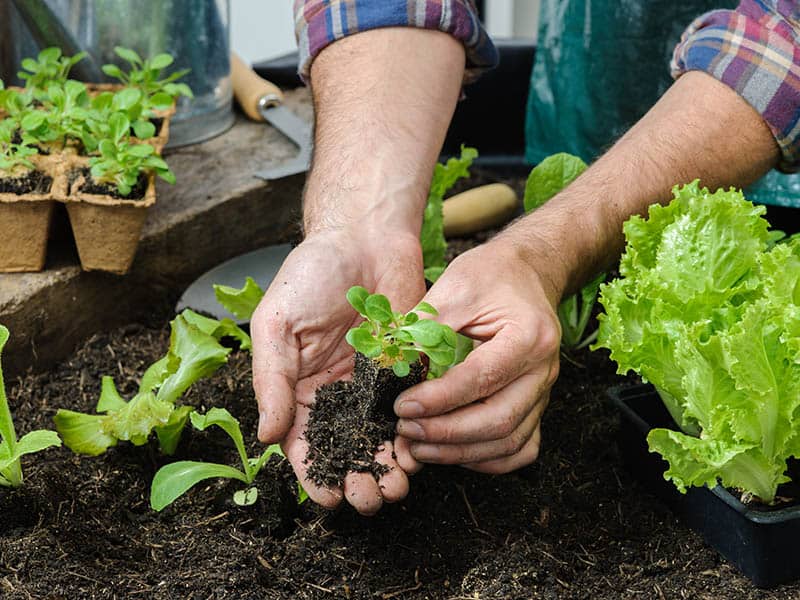
Then, add a thin layer of compost on top of your seeds, water, and let them germinate in a sunny and sheltered location.
Occasionally, water the compost, but don’t wait for it to get dry. Check the tray in about two weeks, and transplant the available seedlings. The seedlings should be between two and three inches above the compost to get ready for transplantation.
Transplant them in pots with excellent drainage and allow every seedling place to develop!
You can put a seedling tray indoors even when it is still cold outside to get sooner crops. Or, go to the nursery and pick seeds for lettuce. Put them in soil and water thoroughly once the weather gets better and there is no frost danger.
Where to Place the Pots?
Now it is time to find the ideal place for your plants. Lettuce needs sunlight to grow, but too much sunlight can cause issues, especially if you live in an area with a warm climate.
Lettuce likes cool weather, and it is at its peak during spring and fall. In summer, lettuce crops can fall because of too much heat and too much sunlight. If your lettuce shows signs of bolting, it means that it went to seed. The leaves become tough, bitter and the sap is milky. When that happens, pull out the plant and harvest the remaining leaves.
You can prevent bolting by limiting the amount of sunlight lettuce receives. Lettuce should receive morning sunlight, and be in partial shade during the warmest parts of the day, especially if you live in a warm climate.
The simple control of sunlight exposure of your lettuce is one of the advantages of container-grown lettuce. You can move the pots to a partial shade location when the weather becomes too hot!
Does Container-Grown Lettuce Need Fertilizer?
The answer is yes and no and fully depends on the soil quality. If you want to provide your seedlings with a quick-growing boost, amend the seedlings with a water-soluble fertilizer when the seedlings grow to four inches. Amend the soil with fertilizer every two weeks.
However, it is an optional step. If you are growing your lettuce in high-quality soil rich in organic matter, fertilization might not be required at all! The plants can take nutrients from the soil.
If you aren’t satisfied with the quality of soil, use fish emulsion as an excellent fertilizer for lettuce.
Apply it every couple of weeks if you are dissatisfied with the development of your lettuce.
Watering Frequency
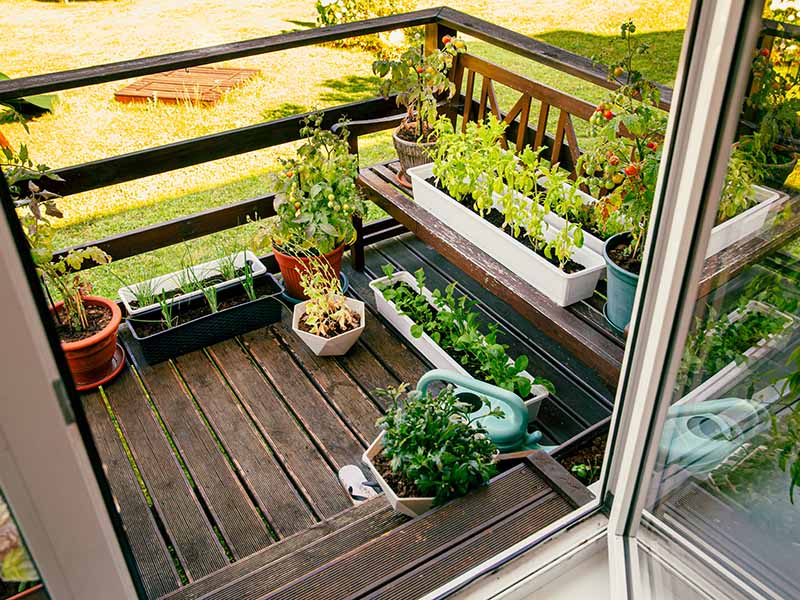
We’re finally at the most important care step when it comes to growing lettuce in containers – watering! Lettuce needs a lot of water. Because it has shallow roots, consistent amounts of water are better than soaking the plant. Container lettuce needs more water than lettuce in garden beds.
On average, lettuce in containers needs more than 2.5 inches of water per week. The optimal watering schedule for moderate temperatures is two times per week. However, before watering the plant, check if the top layer of soil is dry.
During summer, you will need to increase the frequency and possibly water your plants every day.
It takes a bit of practice and trial and error to find out if your lettuce needs more or less water. Underwatered lettuce wilts and has yellow leaves. On the other hand, too much water causes fungal diseases and mushy roots in addition to bacterial growth.
Most Common Lettuce Problems
Unfortunately, lettuce is prone to pests and diseases. Identifying what has attacked your plant will help you to solve the problems.
Here is a brief overview of the most common lettuce problems.
Aphids
Aphids are the most common problem with lettuce. You can identify aphids’ attacks if you notice young leaves curl and demise.
Usually, mixing water and a few drops of dish soap in a spray bottle and spraying the foliage every two days will solve the problems. Doing that for two or three weeks keeps aphids under control.
Caterpillars
Caterpillars can cause the most damage to your lettuce. You can identify the problem if the foliage has holes and is chipped. Sometimes, caterpillars eat the entire leaves!
Natural predators, such as flies and wasps can help keep caterpillars under control in the garden. For your container lettuce, you might need to try a few insecticides to get rid of them.
Azadirachtin is something to try against caterpillars, and may even work against aphids.
Downy Mildew
Downy Mildew can occur in humid and cold areas. It manifests on the foliage undersides as yellow and brown spots and fluffy mold. There isn’t a treatment for downy mildew. When you notice symptoms, you should dispose of the affected foliage or even the whole plant if the head is affected.
Also, you can prevent the disease by ensuring good air circulation between the plants and hurting the optimal watering schedule. Reduce irrigation during cold and humid weather.
Bacterial Leaf Spot
Bacterial leaf spot is easy to identify because of the black lesions on the edges of the leaves. The black lesions are outlined with yellow and they often appear on mature lettuce. The disease is caused by bacteria, and it is more common in the garden.
The highest risk of this disease for container-grown lettuce is planting infected seeds. To ensure you are using healthy, disease-free seeds, soak them in bleach and water and rinse well before planting them.
Bottom Rot
Bottom rot is almost always an issue for garden lettuce. But, it can happen if you use old soil for planting lettuce in the garden. Brown or rust-like spots can appear on midribs if your lettuce suffers from bottom rot. Leaves start to wilt and die off. Like with downy mildew, the treatment includes the removal of affected foliage.
Harvesting Lettuce From Pots
On average, after planting it should pass around four to eight weeks for your lettuce to be ready for harvesting.
Harvesting lettuce is as simple as picking the leaves as you find them crunchy and healthy! But, there is a trick to try to have your lettuce continue growing.
When you harvest leaves, cut them one inch above the main crown. That way, you are not damaging the crown so the plant can continue to grow. Don’t forget to keep watering the lettuce to promote new growth!
Always pick leaves when they are tender because the foliage quality bolts and becomes bitter.
Storing Lettuce
Lettuce is the most delicious when harvested and eaten fresh! But, if you harvest more lettuce than you need, you can wrap the head in a damp paper towel and store it in the refrigerator. A sealed container is a better choice for individual leaves because it will prevent bacteria buildup.
You can store lettuce in the fridge for seven to ten days. Sometimes, it may start to wilt and die sooner than that, especially if you harvested mature plants.
Growing Lettuce in Pots: Frequently Asked Questions
Are you ready to grow lettuce in pots? If you still have questions, check the following section. Ask additional questions in the comment section if you still have some misunderstandings!
Does Lettuce Grow Well in Pots?
Yes, lettuce can thrive in pots, as long as you provide quality soil, optimal moisture, and sunlight. You can also pick loose-leaf varieties for better results!
Will Lettuce Grow Back After Cutting?
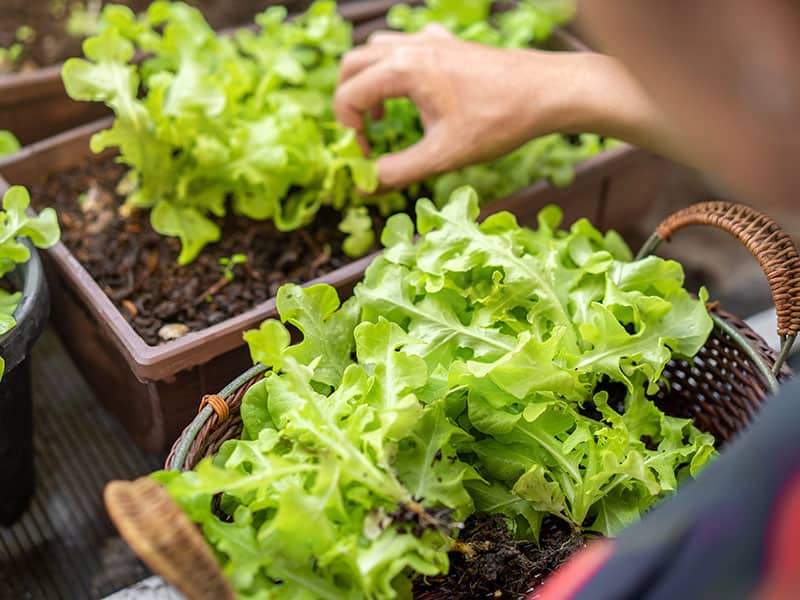
Lettuce can grow back after you cut the leaves if you do it properly. Cut the leaves so you don’t affect the main crown and the leaves will continue to grow.
Does Lettuce Need Full Sun?
During spring and autumn, you can keep lettuce in full sun. But, during summer and hot temperatures, lettuce might prefer partial shade. The ideal sunlight exposure depends on your climate.
How do you Keep Lettuce Growing in the Summer?
The key is to provide a lot of moisture during hot weather. Water lettuce every or every other day. Remember, for lettuce, it is better to water more frequently than soak. Always check if the soil is dry before watering.
Start Your Lettuce in Containers ASAP
Did you know that lettuce is one of the easiest vegetables to grow in gardens or pots? You can even grow it around flowers or other plants if you lack space.
A great thing about lettuce is that you can start the seeds indoors and speed up the process. That way, you’ll have fresh lettuce sooner than you expected.
The basic lettuce care is simple – good soil, frequent and shallow watering, and good harvesting technique! That way, you can enjoy fresh and crisp lettuce year-round!
Did you find the information you were searching for? If you have more growing tips for lettuce, please share them!
